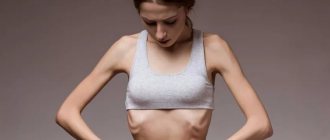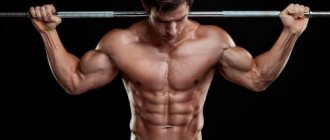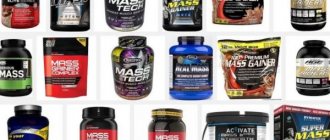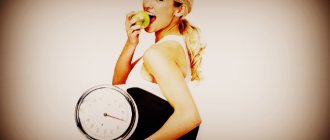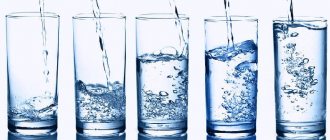Carbohydrates as fuel
Carbohydrates are the main source of energy for muscle function during strength training. They are stored in the muscles as glycogen. This "fuel" is used to deliver short but powerful bursts of energy. The more active and longer the muscles work, the more glycogen they require. Therefore, carbohydrate requirements vary depending on the intensity and duration of the workout. For those who train at a leisurely pace for no more than an hour, a minimum of two grams of carbohydrates
per kilogram of body per day may be required. Complex and intense workouts lasting more than two hours increase the need for carbohydrates. For the average man who exercises regularly and intensely, experts recommend consuming a minimum of 400-600 grams of carbohydrates per day. Preference should be given to “slow” carbohydrates, which are found in cereals, grain products, vegetables and fruits.
How to lose weight through sports
Alexey Korochkin, a researcher at the Department of Exercise Therapy and Sports Medicine at the Russian State Medical University, talks about how to eat for a person who is training to lose weight, not gain muscle mass.
Menopause and weight gain
25.08.2020
Menopause occurs when a woman stops ovulating and menstruation stops. As women age between 40 and 50 years of age, there is a tendency to gain weight; this can be influenced by lifestyle factors such as diet and exercise. belly fat is associated with hormonal changes during menopause . Being overweight in midlife is associated with an increased risk of cardiovascular disease and diabetes .
Body changes during menopause
As we age, our muscles shrink and our metabolism slows. These changes may contribute to weight gain during menopause .
Other physical changes associated with menopause:
- skin changes such as dryness and loss of elasticity;
- vaginal dryness ;
- hair growth (or loss).
These changes can affect a woman's body image and self-esteem and increase the risk of depression and sexual difficulties. menopausal symptoms may help .
Distribution of estrogen and fat during menopause
Changing hormone , mainly estrogen, can affect the distribution of fat in the body. Many women during menopause and in the early years after menopause gain fat mass as estrogen levels decrease. Women of childbearing age tend to accumulate fat in the lower body (becoming "pear-shaped"), while postmenopausal women accumulate fat around the abdomen (becoming "apple-shaped").
Animal studies have shown that a lack of estrogen leads to unwanted abdominal fat, although the exact mechanisms are not yet understood.
Other causes of weight gain during menopause
In addition to decreased estrogen levels, other factors that may contribute to weight gain after menopause include:
- age;
- decreased physical activity;
- number of children;
- family history of obesity ;
- use of antidepressants or antipsychotic drugs;
- chemotherapy;
- decreased metabolic rate;
- Changed lifestyle - for example, eating out.
Hormone replacement therapy
weight gain is not associated with HRT, also known as menopausal therapy . In fact, some studies suggest that HRT use is associated with less fat gain and potential beneficial effects on muscle mass.
A woman in middle age may gain weight regardless of whether she uses HRT. Some women may experience symptoms at the beginning of treatment, including bloating and fullness in the breasts , and these may be mistaken for weight gain. These symptoms usually disappear within three months after the dosage of therapy is adjusted to suit the individual.
Menopause and cardiovascular disease
As women get older, their risk of heart disease increases. This may be partly due to the postmenopausal tendency to gain weight around the abdomen . Fat stored in the abdominal wall and around internal organs (visceral fat) is a risk factor for cardiovascular disease.
Hormone replacement therapy can reduce the risk of heart disease by preventing the accumulation of abdominal fat. In addition, replacing estrogen increases levels of “good” cholesterol.
Managing weight gain associated with menopause
To control your weight after menopause, try:
- Eat a healthy diet (controlling calories will help with weight loss). Options such as the low-carb diet or diet may be beneficial for some women;
- engage in regular and long-term aerobic exercise. This will give your metabolism a boost. Get at least 30-60 minutes of moderate physical activity on most days;
- build and maintain muscle mass through strength training;
- Accept the changes in your body that come with age and work to reduce your risk by following healthy lifestyle measures;
- Practicing yoga can help reduce your waist size and weight.
Avoid crash diets
A crash diet involves significantly reducing the amount of food you eat in a short time. Due to the body changes that occur in your muscles, this will cause you to gain weight when you start eating normally again.
Leptin (the "fat hormone") plays an important role in weight management as it helps control appetite and metabolic rate. Research shows that leptin levels drop after a diet that increases appetite and slows metabolism.
Published in Gynecology Premium Clinic
Proteins as building materials
Protein helps repair muscle tissue damaged during exercise and also increase its volume. Since protein is the main building material for muscles, those who are keen on strength training require more protein food than people leading a sedentary lifestyle. Keep in mind that most recreational athletes seriously overestimate their protein needs
and consume excess amounts of it.
According to experts, a person needs about 0.4 g of protein per kilogram of body weight per day. For those involved in strength training, sports nutritionists recommend increasing protein intake to 0.6-0.8 g per kilogram of body weight. However, in no case should you consume more than 450 g of protein per day! The approximate norm is from 90 to 115 g
of protein per day for a person weighing about 70 kg and
from 130 to 170 g
of protein per day for those who weigh 90 kg. Avoid drinking protein shakes. Adequate amounts of high-quality protein can be obtained from low-fat dairy products, eggs, lean meats, chicken and fish. Pay attention to a variety of plant protein sources: vegetables, nuts and legumes.
Sports nutrition for a diet to gain muscle mass
Sports nutrition requires a person to strictly adhere to time limits and consume specific products, which is not always possible due to various circumstances. So, it is quite problematic for a working person to eat a variety of dishes 6 times a day. Therefore, athletes come to the aid of supplements that are designed taking into account their goals.
Such additives include:
- Gainers.
They are used to “get” the required amount of calories, as well as to ensure that protein is absorbed by the body more quickly. Gainers are drunk an hour before training so that the calories from them do not begin to be stored as fat. You can also use them after classes.
- Protein based powders.
These powders are protein sources that you mix into a mass gainer and drink before your workouts.
- Creatine
, which helps retain moisture in the muscles. Drink it before the upcoming workout, 40 minutes before it starts.
- Glutamine.
Glutamine is an amino acid found in muscles. The body produces it on its own, but athletes take it as a supplement.
Glutamine is taken before bed to achieve the following goals:
- Reduce protein costs;
- Reduce muscle pain;
- Activate immunity;
- Stimulate the production of growth hormone;
- Break down fats faster;
- Increase the amount of glycogen in the body;
- Prevent the toxic effects of ammonia on the body.
- BCAA group.
This abbreviation contains three amino acids: valine, leucine and isoleucine.
Goals that can be achieved by taking BCAAs:
- Reducing the harm that catabolism causes to the body (prevents the growth of muscle mass);
- These amino acids are essential for protein production;
- BCAAs are an additional source of energy for the body.
- Omega-3.
The purpose of taking polyunsaturated fatty acids:
If a person trains intensively, then he needs 4.5 times more glutamine. Indeed, during the growth of muscle mass in the blood, the level of glutamine drops by 18%.
An athlete consumes 5-7 g of the supplement per kg of weight per day. In adolescence, the dosage of 3-4 g per kg of weight should not be exceeded. There are also natural foods that contain glutamine - eggs, fish, beef, legumes, cabbage, parsley and spinach. You can also prepare yourself a sports cocktail, for which 10 g of the additive is diluted in 250 ml of water. Drink this drink in the morning on an empty stomach, after exercise and before a night's rest.
The more intensely a person trains, the more he needs these amino acids. If these reserves are not replenished, the body will begin to burn muscle tissue.
There are foods that are natural sources of BCAAs - peanuts, tuna, eggs, turkey and chicken, beef and salmon. If an athlete needs BCAAs, then the supplement is introduced into the diet before training and immediately after its completion. You can combine BCAA with gainer, protein and keratin.
- Improving brain function;
- Improved blood supply;
- Decreased appetite;
- Normalization of metabolic processes;
- Preventing muscle burning;
- Boosting the immune system;
- Prevention of heart and vascular diseases.
Foods that contain Omega-3 include: tuna, salmon, mackerel, halibut, herring, trout, flaxseed, oat germ, beans and walnuts. Daily intake of Omega-3 should be equal to 2-3 g per kg of weight. These healthy fats can also be taken in capsules as a food supplement, 2-6 g per day.
Find out more: Interesting Experiments and Research on the Amazing Benefits of Omega 3
Water reserves
In addition to the mandatory one and a half liters of water that a person should drink daily, a lover of strength training should take care to replenish fluid reserves lost during training.
To prevent dehydration, drink two glasses of water two hours before class. Also, take a large sip of clean drinking water every 15-20 minutes during your workout. If you want to know exactly how much fluid you're losing, weigh yourself before and after your workout. For every half a kilogram lost during exercise, about 400 g of water is consumed. This is how much you need to drink afterwards to replenish fluid loss. Defining goals
Do you want to lose weight or gain muscle? Relax with exercise or come out of hibernation? Find out how to choose the physical activity that's right for you.

